Speech Aspects of Australia's Finances

Ric Battellino
Deputy Governor
Address to Financial Executives International of Australia
Sydney –
Given the financial orientation of this group, I thought I would focus my remarks today on some aspects of Australia's finances. In particular, I want to deal with three questions that often come up when I talk to analysts and bankers from overseas. These are:
- are Australian households over-geared?
- does Australia have too much foreign debt? and
- do Australian banks rely too much on foreign wholesale funding?
Before I move on to these questions, I should note that, in my experience, foreigners never ask about government debt in Australia, or corporate debt for that matter. It is not hard to understand why, as both government and corporate debt in Australia are low by international standards.
Household Debt
Let me then start with household debt.
The Reserve Bank monitors developments in household debt very closely as they have significant implications for the economy.
Glenn Stevens summarised the Bank's view on this last week when he noted that, while households had coped well with current levels of debt, it would not be wise for there to be further big increases in household indebtedness.
As you know, household debt has risen significantly faster than household income since the early 1990s. At that time, households on average had debt equal to half a year's disposable income; by 2006, debt had risen to around one and a half years' income. Since then, however, the ratio of debt to income has stabilised (Graph 1).
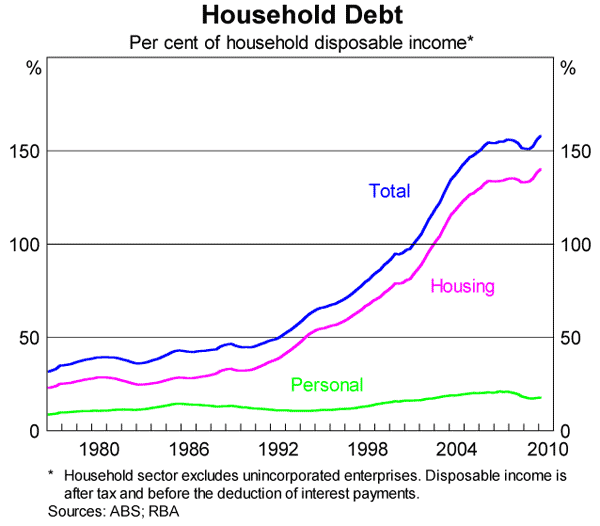
Most of the rise was due to housing debt, including debt used to fund investment properties. Other household debt, which includes credit card debt, car loans, margin loans and so on, has not changed much relative to income over the period.
The current household debt ratio in Australia is similar to that in most developed countries (Graph 2).[1] Significant exceptions are Germany and France, where the ratios are lower, at around one year's income, and the Netherlands, where the ratio is much higher – almost 2½ years' income – due to the tax incentives for households to stay geared up.
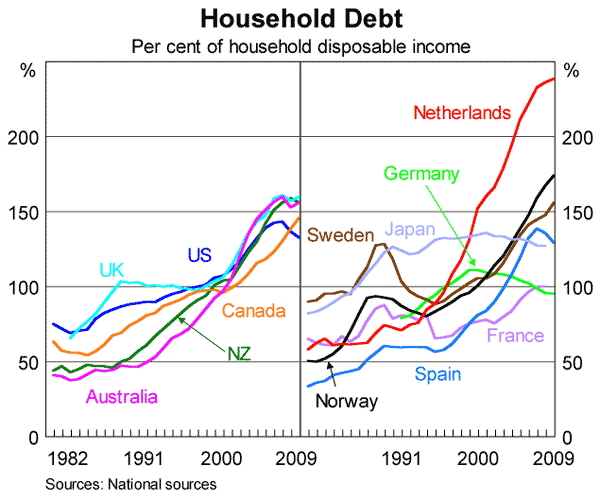
All countries have experienced rises in household debt ratios over recent decades. Clearly, therefore, the forces that drove the rise in household debt ratios were not unique to Australia. The two biggest contributing factors were financial deregulation and the structural decline in interest rates.
One of the consequences of financial deregulation was that the availability of credit to households greatly increased. Up to the 1980s, the various controls on the financial sector meant that the ability of households to obtain credit was constrained. Even obtaining a housing loan was relatively difficult. However, after financial regulations were eased around the globe, many new financial products were developed specifically for households, and particularly relating to housing finance. Households found it was much easier to get a loan. Most loans products have worked well, though some have caused significant problems; sub-prime loans in the United States are the clearest example.
The level of interest rates in most developed economies in the past decade has been about half that in the decade to 1995. This structural decline in interest rates has facilitated the increase in household debt ratios because it reduced debt-servicing costs (Table 1). Households have therefore found that they can now service more debt than used to be the case.
| 1985–1995 | 2000–2010 | |
|---|---|---|
| New Zealand | 12.7 | 5.9 |
| Australia | 11.4 | 5.3 |
| United Kingdom | 10.1 | 4.2 |
| Canada | 8.7 | 3.1 |
| Germany | 5.9 | 2.9 |
| United States | 6.2 | 2.9 |
Sources: Thomson Reuters; central banks |
||
Has the rise in household debt left households over-exposed financially? In trying to judge this, there are a few considerations to take into account.
First, at the same time as the household debt ratio has risen, so too have the assets held by households. Some commentators might dismiss this as simply reflecting the fact that the additional debt has been used to inflate asset values. There is some basis for this in relation to housing assets but, even if we exclude housing and focus only on households' financial assets, the statement is still true. Financial assets held by households have risen to the equivalent of 2.75 years of household income, up from 1.75 years' income in the early 1990s.
Second, the available data suggest that the increased debt has mostly been taken on by households which are in the strongest position to service it. For example, if we look at the distribution of debt by income, we can see that the big increases in household debt over the past decade have been at the high end of the income distribution (Graph 3). Households in the top two income quintiles account for 75 per cent of all outstanding household debt (Graph 4). In contrast, households in the bottom two income quintiles account for only 10 per cent of household debt.
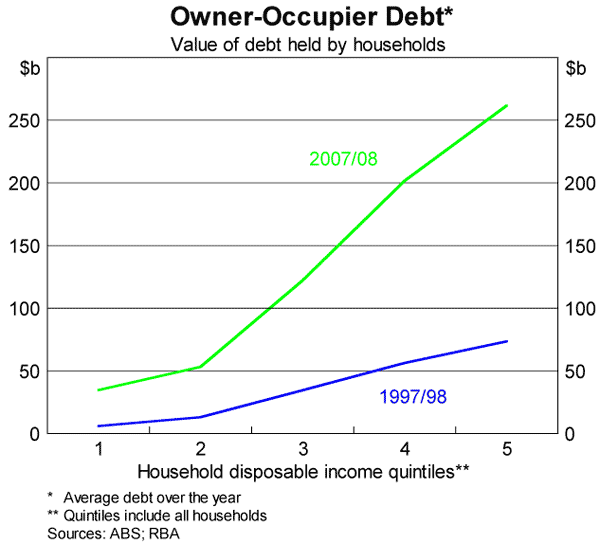
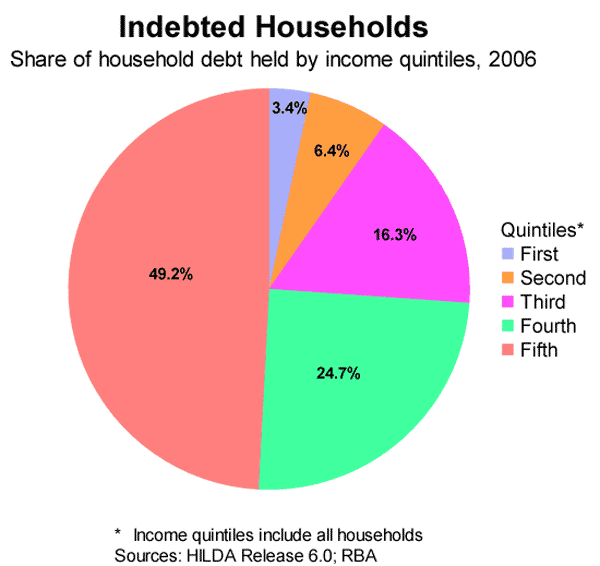
If we look at the distribution of debt by age of household, we see that the increased debt has mainly been taken on by middle-aged households. The proportion of 35–65 year olds with debt increased significantly through to 2008, as households have been more inclined to trade up to bigger or better located houses, and to buy investment properties. Households under 35 years of age (i.e. the group that would typically encompass first-home owners), in contrast, have seen a fall in the proportion with debt (Graph 5).
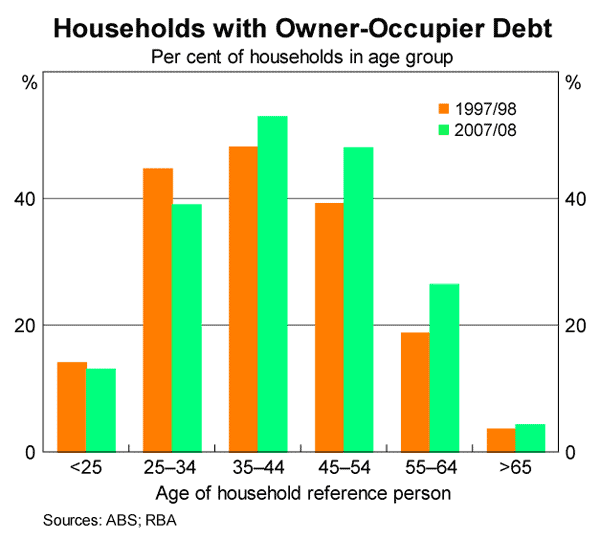
Another factor that has contributed to the resilience of household finances is that, by and large, the debt has not been used to increase consumption. Apart from some brief periods, household consumption has not been unusually elevated during this period of rising debt. Rather, the debt has mainly been used to acquire assets.
Perhaps the best, and most direct, indicator of households' capacity to support the increase in debt is the arrears rates on loans. This remains very low in Australia. The current arrears rate is around 0.7 per cent. This is one of the lowest rates among developed economies (Graph 6). Other data also suggest that households' aggregate debt-servicing capacity is quite strong: in recent years more than half of owner-occupiers have been ahead of schedule on the repayments on the loan they took out to buy their property.
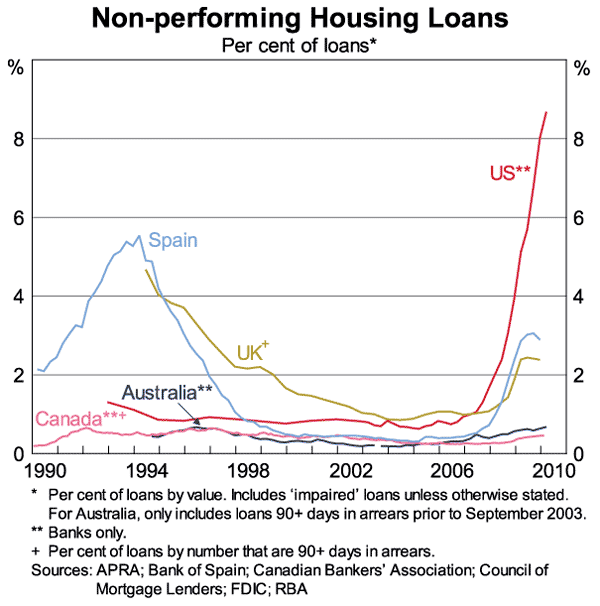
Within this relatively benign aggregate figure, pockets of stress have emerged from time to time. We saw this clearly in the south-western suburbs of Sydney following the sharp run-up in Sydney house prices over 2002 and 2003. More recently there are some signs of increased housing stress in south-east Queensland and Western Australia, again following sharp rises in house prices in these areas.
Another segment of the market that will bear close watching is first-home owners. They have accounted for an unusually high proportion of housing purchases over the past couple of years – around 40 per cent. This has reflected the incentives created by various first-home owner concessions. Most of these purchases have been funded by floating rate mortgages, and the average loan to valuation ratio is relatively high, at around 90 per cent. Clearly, this group will be very sensitive to changes in interest rates.
In summary, if we look at the way the increase in household debt has been distributed, what households have done with the money, and the arrears rates on loans, it is reasonable to conclude that the household sector has the capacity to support the current level of debt. Having said that, the higher the level of debt the more vulnerable households are to shocks that might affect the economy. We at the Reserve Bank therefore welcome the fact that the household debt ratio has flattened out in recent years and, as Glenn Stevens remarked last week, there would be benefits in that stability continuing.
Foreign Debt
Let me now turn to the question of Australia's foreign debt.
Following the floating of the exchange rate and the removal of capital controls in the early 1980s, both foreign investment in Australia and Australian investment abroad increased sharply as the Australian economy became more integrated into the global financial system (Graph 7). In net terms, capital inflows increased from around 2 per cent of GDP to around 4 per cent, and, in the latest decade, to an average of almost 5 per cent of GDP. The current account deficit widened correspondingly, since with a floating exchange rate the current account and capital account balances must be equal and offsetting, both being determined simultaneously through the interaction of a wide range of economic and financial forces.
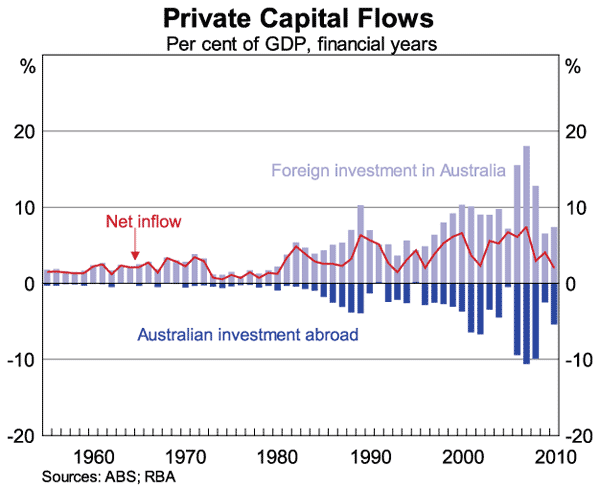
The pick-up in net capital inflow meant that the ratio of net foreign liabilities to GDP rose. From around 20 per cent in 1980, it rose to around 50 per cent by 1995. It then flattened out for a decade, but in recent years the further increase in net capital inflow has seen the foreign debt ratio rise again (Graph 8).
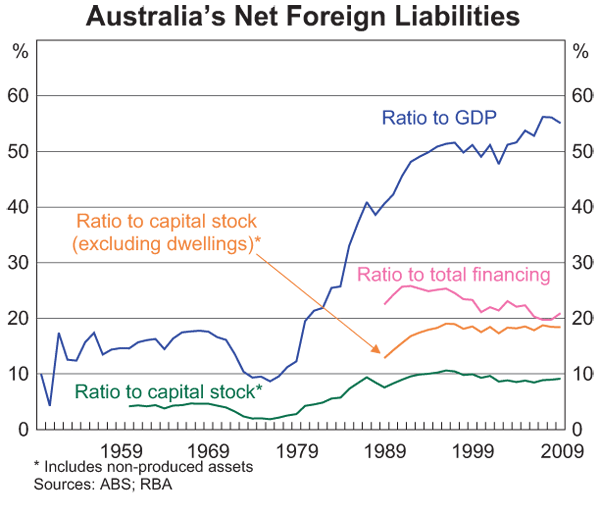
Expressing foreign liabilities relative to GDP is, perhaps, the most common way in which people analyse them. For emerging markets, this measure has been shown to have some association with vulnerability to balance of payments crises. This is because emerging market economies often have a fixed or managed exchange rate and their foreign liabilities tend to be denominated in foreign currency, rather than domestic currency. In such instances a rise in the ratio of foreign liabilities to GDP does indicate increased vulnerability as it signals an increase in the country's foreign exchange risk and liquidity risk.
For a developed economy that can borrow overseas in its own currency, and which has a floating exchange rate, the significance of a rise in the ratio of foreign liabilities to GDP is less clear. It also needs to be kept in mind that, as economies develop, most financial variables rise relative to GDP. This seems to be a consequence of financial deepening. Expressing net foreign liabilities as a percentage of the total financing in the economy is, perhaps, more relevant, since it gives some indication of the proportion of the economy's funding that is coming from offshore. In Australia, this ratio has remained relatively steady since the late 1980s, at a little over 20 per cent.
Foreign liabilities can also be measured relative to the physical capital stock of the country, giving an indication of the proportion of the capital stock being funded by foreigners. This ratio, too, has been relatively steady in Australia since the late 1980s, at around 10 per cent.
One could argue that housing assets should be excluded from this latter measure, since foreigners' participation in the housing market is relatively limited. On that basis, the ratio rose somewhat in the early 1990s, but has been relatively steady since.
In short, these measures do not suggest the build-up of any significant disequilibrium in the economy resulting from foreign liabilities.
For developed economies with a floating exchange rate and the capacity to borrow offshore in their own currency, the risk from rising foreign liabilities is not that they will cause a traditional balance of payments crisis, but that they will undermine financial stability. The process by which this can happen typically starts with a country, for one or more reasons, becoming attractive to foreign investors. Capital floods in, overwhelming the capacity of the economy to use it productively. Credit is misallocated and eventually there is some form of a domestic financial crisis. This type of crisis can occur even in highly sophisticated economies, as illustrated by the recent sub-prime crisis in the United States.
The policy challenge for countries in this situation is to ensure that the ready availability of offshore funds does not end up distorting or weakening the financial side of the economy.
As the recipient of large amounts of offshore funds for much of the post-float period, Australia has had to remain alert to these challenges. By and large, it has been able to successfully absorb significant amounts of offshore capital over many years. There are several factors that have contributed to this:
- First, the country's foreign liabilities are virtually all either in Australian dollars or hedged back to Australian dollars.[2] Australia is able to do this because foreign investors are happy to hold a certain proportion of their assets denominated in Australian dollars. This means that Australian borrowers do not face foreign exchange risk on the capital sourced from overseas. Therefore, if sentiment turns and the exchange rate falls, domestic borrowers are largely unaffected. The large swings in the exchange rate of the Australian dollar that have occurred over the past couple of decades in no way threatened the corporate and financial sectors.
- Second, the offshore capital that has flowed into Australia has been used essentially to fund high levels of investment. Australia uses foreign capital not because its national saving ratio is low, but because its investment ratio is high by the standards of developed economies (Table 2). In the past decade, for example, the national savings rate in Australia has averaged 22 per cent, much the same as in Europe and well above the figure of 15 per cent in the US and UK. Over the same period, the investment ratio in Australia averaged 27 per cent, whereas in most developed economies it has averaged around 20 per cent. This high ratio of investment to GDP is, I believe, an indication that Australia is using foreign capital productively, and sustaining the capacity of the country to service that capital.
| National saving |
National investment |
|
|---|---|---|
| Australia | 22 | 27 |
| Canada | 23 | 21 |
| France | 20 | 20 |
| Germany | 22 | 18 |
| Japan | 27 | 23 |
| United Kingdom | 15 | 17 |
| United States | 15 | 19 |
Source: ABS; IMF |
||
- Third, credit standards, by and large, have remained robust and the amount of capital wasted through bad loans has remained limited.
Foreign Borrowing by Banks
Within Australia's total foreign liabilities, the proportion accounted for by the foreign borrowing of Australian banks has increased. Virtually all this rise took place through the decade of the 1990s. Banks accounted for a little over 20 per cent of Australia's foreign liabilities in 1990 but, by 2001, this had risen to around 40 per cent. It has not changed much in the past decade (Graph 9).
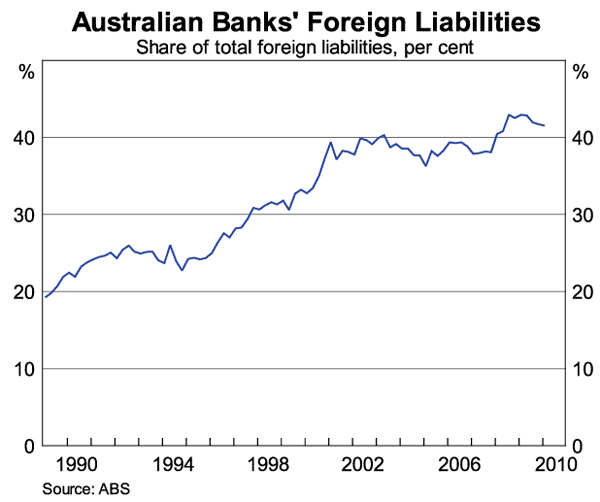
Part of this trend was the result of banks adjusting their balance sheets following financial deregulation and the growth of financial markets. These developments gave banks the opportunity to move from deposit funding to various forms of funding through markets, as a way of diversifying funding sources or reducing funding costs (Graph 10).
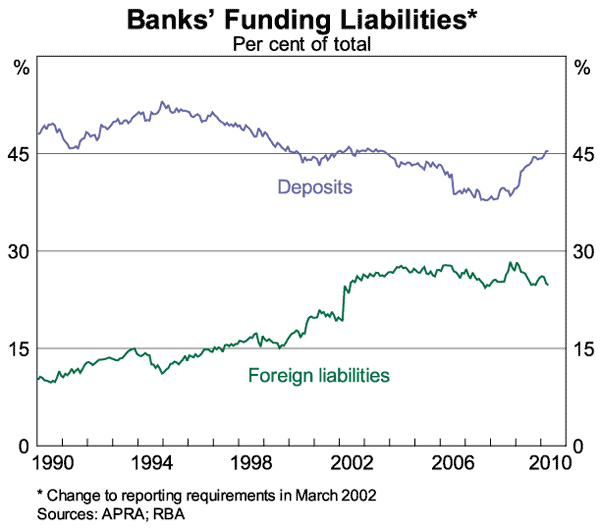
The growth of the superannuation industry, following government decisions to promote compulsory superannuation, probably contributed to this trend. Firstly, it meant households became less inclined to hold their savings as bank deposits, and second, the pool of funds created by superannuation increased demand for securities such as bank securities.
Within this trend away from deposits to funding through securities markets, there were also forces that resulted in banks increasing their use of offshore funding. As an example, a substantial proportion – about 20 per cent – of superannuation savings flow offshore, mainly into foreign equities. This reduces the pool of savings available domestically to banks and, other things equal, increases the amount of offshore funding banks need to undertake.
It is also an inescapable fact that, with Australia running a current account deficit, some funding for the economy needs to come from offshore. Households, by and large, cannot borrow offshore and the government sector has not had much need for offshore funding. That leaves the corporate and the financial sectors. Of these, the financial sector has a comparative advantage in offshore borrowing, because of the relatively high credit rating of Australian banks, both compared with Australian corporations and, in recent years, with banks in other countries.
Banks in Australia have therefore established a significant role in intermediating the flow of funds from overseas to Australia. Banks in countries where there are surplus savings, such as those in Europe, play a similar role, though in reverse; they channel funds from domestic savers to offshore.
There is a natural tendency to believe that it is riskier for banks to borrow offshore than to lend offshore. Events over the past few years, however, have shown that one activity is not intrinsically more risky than the other. It is a matter of how the risks are managed. In the lead up to the financial crisis, for example, European banks were running very significant risks through their offshore lending, not only in terms of the credit quality of the US assets they were buying, but also in terms of the short-term nature of some of the funding transactions that supported those assets. The US dollar shortages that keep recurring in global money markets are manifestation of those funding risks. These risks were largely unrecognised and, it seems, not very well managed.
The Australian banks have long recognised the risks that come from their business model, and, in my experience, are very focused on understanding those risks and managing them. This contributed to their relatively good performance through the global financial crisis.
Conclusion
You may have noticed that I have not given categorical answers to the three questions I listed at the start of my talk. This is because I don't think it is possible to give simple ‘yes’ or ‘no’ answers to these questions.
However, looking at a broad range of financial data, and considering the fact that the Australian economy and financial system have exhibited a high degree of stability over many years, despite the many global events that have tested their resilience, is, I think, grounds for confidence that the economic and financial structure that has evolved in Australia is sustainable.
Endnotes
Note that there is no particular reason why household debt ratios should be the same across countries. [1]
D'Arcy P, M Shah Idil and T Davis (2009), ‘Foreign Currency Exposure and Hedging in Australia’, RBA Bulletin, December, pp 1–10. [2]